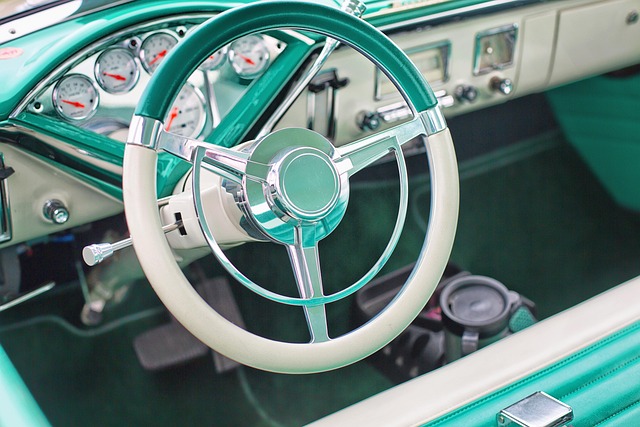Looking to register your car in California? This comprehensive guide breaks down the process step-by-step. First, understand the eligibility requirements for car registration, including vehicle condition and ownership verification. Next, gather essential documents like proof of insurance, title, and a valid driver’s license. Visit your local California DMV office, complete a VIN verifier inspection to ensure your vehicle meets safety standards, then transfer the title and pay registration fees. Receive your license plate and hit the road legally!
- Understand Eligibility Requirements for Car Registration
- Gather Necessary Documents for Car Registration
- Visit Your Local California DMV Office
- Complete Vehicle Inspection and Title Transfer
- Pay Registration Fees and Obtain License Plate
Understand Eligibility Requirements for Car Registration

Before registering your car in California, it’s crucial to understand the eligibility requirements set by the Department of Motor Vehicles (DMV). To ensure a smooth registration process, verify that your vehicle meets all necessary criteria. One essential step is to have a valid Vehicle Identification Number (VIN) inspection conducted by an approved entity or using a mobile VIN verification service. This involves scanning the unique 17-character VIN to check its authenticity and history, which helps detect any potential issues or discrepancies related to the car’s origin and condition.
Additionally, ensure that your vehicle is eligible for registration based on factors like age, emissions standards, and safety features. The DMV provides guidelines for different types of vehicles, including cars, trucks, and motorcycles. A mobile VIN inspection or verification service can prove invaluable in this process, offering convenience and a comprehensive check-up to meet California’s registration standards.
Gather Necessary Documents for Car Registration

Before registering your car in California, make sure to gather all the essential documents required by the Department of Motor Vehicles (DMV). This includes proof of ownership, typically a vehicle title or bill of sale, along with valid identification such as a driver’s license or state ID card. Additionally, you’ll need a current registration from another state if applicable, and a completed DMV form for vehicle registration.
One crucial step is to obtain a Vehicle Identification Number (VIN) verifier from the DMV. This service ensures the VIN on your car matches the records, preventing fraud. You can also opt for a mobile VIN verification or inspection for added convenience. These services allow you to complete the initial checks from the comfort of your home or even while you’re at the DMV, making the registration process smoother and faster.
Visit Your Local California DMV Office

Before you begin the registration process, it’s crucial to visit your local California DMV office. This is where you’ll initiate the official procedures and ensure all necessary documents are in order. The staff at the DMV can guide you through each step, making the process smoother. They will also conduct a Vehicle Identification Number (VIN) inspection to verify the vehicle’s authenticity and history, using advanced tools like a DMV VIN verifier.
At this stage, consider utilizing a mobile VIN verifier for added convenience. This service allows you to check your car’s history remotely, providing valuable insights into its past ownership, maintenance records, and potential issues. By combining in-person visits with mobile verification, you can ensure a seamless registration experience tailored to California’s requirements.
Complete Vehicle Inspection and Title Transfer

After gathering all necessary documents, it’s time to complete the vehicle inspection and title transfer processes. In California, this involves a comprehensive check-up performed by a DMV-approved vin verifier to ensure your car meets safety standards. The process begins with verifying the Vehicle Identification Number (VIN) using a reliable tool like a mobile vin verifier or the official DMV VIN lookup service. This step is crucial as it confirms the vehicle’s history and ensures there are no outstanding issues that could hinder registration.
Once the VIN inspection is complete, you can initiate the title transfer. This involves submitting the necessary paperwork to the California DMV, including proof of ownership and any required fees. A mobile vin verifier can be particularly handy during this phase by providing quick and accurate vehicle history reports on-the-go, streamlining the entire registration process.
Pay Registration Fees and Obtain License Plate

After completing your car’s purchase, it’s time to register your vehicle with the California Department of Motor Vehicles (DMV). The registration process involves several steps, including paying the required fees and obtaining a set of license plates. To streamline this process, many Californians opt for a mobile VIN verifier or mobile VIN inspection service. These services allow you to verify your car’s history and identify any potential issues from the comfort of your home or even before heading to the DMV.
Once your vehicle’s details are confirmed, you’ll be directed to pay the registration fees using various payment methods accepted by the DMV. After processing your application, a set of personalized license plates will be issued, which you can then display on your vehicle. Always ensure that your car is properly inspected and all necessary documentation is in order before taking it on the road, as fines for unregistered vehicles are strictly enforced by the DMV and local law enforcement agencies.
Registering a car in California is a straightforward process that requires understanding specific eligibility criteria, gathering essential documents, and visiting your local DMV office. By completing a vehicle inspection and title transfer, along with paying relevant fees, you’ll be on your way to securing your new car’s registration. Remember to utilize a reliable DMV VIN verifier for accurate verification during the title transfer stage.
